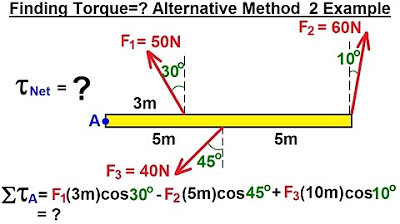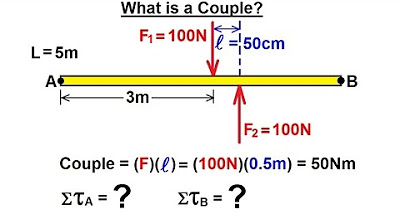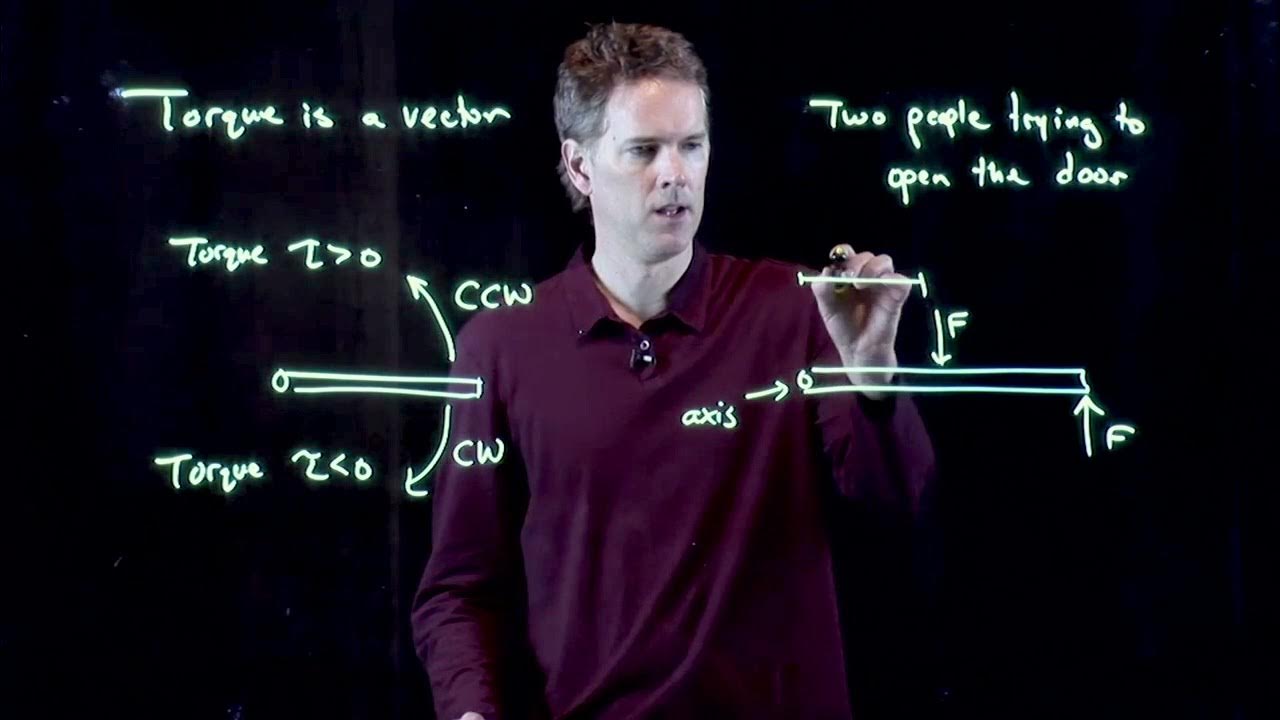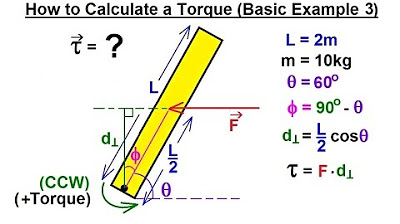Physics 15 Torque Fundamentals (11 of 13) How to Calculate the Net Torque? Ex. 2
TLDRThe video script discusses the concept of net torque on a beam subjected to two forces (F1 and F2) at angles to the perpendicular. It explains that while the principle of torque calculation remains the same, the angles of the forces must be considered. The net torque is calculated by summing the torques from both forces, taking into account their directions to determine if they are positive or negative. The example provided involves calculating the net torque with F1 causing a positive torque and F2 a negative one. The calculation involves multiplying each force by the distance from the pivot and the cosine of the respective angles (θ1 and θ2). The final result is a negative torque, indicating a clockwise rotation. The script emphasizes the importance of considering the direction of the torque when calculating the net torque.
Takeaways
- 📐 **Angle Consideration**: Unlike the previous example, both forces (F1 and F2) are now acting at an angle relative to the perpendicular of the beam, which must be taken into account when calculating torque.
- ⚙️ **Net Torque Calculation**: The net torque is the sum of the torques caused by each force (torque1 + torque2), considering their directions and whether they contribute positively or negatively to the rotation.
- ➕ **Positive Torque by F1**: Force F1, if acting alone, would cause a counterclockwise rotation, which is considered a positive torque.
- ➖ **Negative Torque by F2**: Force F2, if acting alone, would cause a clockwise rotation, resulting in a negative torque.
- 🔢 **Torque Formula**: The torque caused by a force is calculated as the product of the force, the distance from the pivot to where the force is applied, and the cosine of the angle between the force's direction and the perpendicular.
- 📐 **Cosine of Angles**: The cosine of the angle (θ1 for F1 and θ2 for F2) is used to determine the component of the force that contributes to the torque.
- 🔢 **Force and Distance**: The force values (40 Newtons for F1 and 30 Newtons for F2) and the distance from the pivot point (half the length of the beam, L/2) are used in the torque calculation.
- 📐 **Cosine Values**: Cosine of 20 degrees (θ1) is approximately 0.94, and cosine of 30 degrees (θ2) is 0.866, which are used to find the torque values for each force.
- 🔢 **Calculation Example**: For F1, the torque is calculated as 40 Newtons times 2 meters (half the beam's length) times cosine of 20 degrees. For F2, it's 30 Newtons times the full length of the beam (2 meters) times cosine of 30 degrees.
- 🔢 **Net Torque Result**: The net torque is found by subtracting the torque caused by F2 from that caused by F1, resulting in a negative value indicating a clockwise torque.
- ➡️ **Direction of Torque**: A negative torque value signifies a clockwise direction of the torque, which in this context means the beam will rotate into the board.
- 📝 **Final Consideration**: It's important to consider the direction of the torque when interpreting the results, as it affects the understanding of how the forces will rotate the beam.
Q & A
What is the primary concept being discussed in the transcript?
-The primary concept discussed is the calculation of net torque on a beam when forces are acting at an angle relative to the perpendicular of the beam.
How does the direction of force affect the torque on the beam?
-The direction of the force affects the torque by determining whether the torque is positive (counterclockwise rotation) or negative (clockwise rotation).
What is the formula for calculating the net torque when forces are acting at an angle?
-The net torque is calculated as the sum of the individual torques, taking into account the cosine of the angle between the force's direction and the perpendicular.
What is the significance of cosine in the torque calculation?
-The cosine function is used to adjust the force's value based on the angle it makes with the perpendicular to account for the effective force component that contributes to the torque.
What does a negative torque value indicate in the context of the beam?
-A negative torque value indicates that the combined effect of the forces will cause a clockwise rotation of the beam.
How is the direction of the torque related to the net torque's sign?
-The sign of the net torque corresponds to the direction of the intended rotation: positive for counterclockwise and negative for clockwise.
What are the two forces, F1 and F2, acting on the beam in the example?
-In the example, F1 is 40 Newtons and F2 is 30 Newtons, both acting at different angles to the perpendicular of the beam.
What is the length of the beam in the given example?
-The length of the beam in the example is 2 meters.
What are the angles, theta1 and theta2, associated with the forces F1 and F2 respectively?
-Theta1 is 20 degrees associated with force F1, and theta2 is 30 degrees associated with force F2.
How does one determine the effective torque caused by each force?
-The effective torque for each force is determined by multiplying the force by the perpendicular distance from the pivot point to where the force is acting, and then by the cosine of the angle the force makes with the perpendicular.
What is the final calculated net torque on the beam in the example?
-The final calculated net torque is -14.4 Newton meters, indicating a clockwise torque.
Why is it important to consider the angle of the forces when calculating torque?
-Considering the angle is important because it determines the effective component of the force that produces torque, which is crucial for accurately calculating the potential rotation or twisting effect on the beam.
Outlines
📐 Calculating Net Torque with Angled Forces
This paragraph discusses the calculation of net torque on a beam subjected to two forces, F1 and F2, which are not perpendicular to the beam but act at an angle. The principle of torque calculation remains the same, but the angles of the forces must be considered. The net torque is the sum of the individual torques, taking into account their directions to determine if they are positive or negative. F1 causes a positive torque as it would rotate the beam counterclockwise, while F2 causes a negative torque as it would rotate the beam clockwise. The net torque is calculated by multiplying each force by its respective distance from the pivot point (L/2 for F1 and L for F2) and the cosine of the angle between the force's direction and the perpendicular (θ1 for F1 and θ2 for F2). Substituting the given values (F1 = 40 N, F2 = 30 N, L = 2 m, θ1 = 20°, θ2 = 30°), we find that the net torque is negative, indicating a clockwise rotation.
Mindmap
Keywords
💡Electron Line
💡Torque
💡Beam
💡Forces F1 and F2
💡Angles
💡Cosine
💡Net Torque
💡Positive and Negative Torque
💡Clockwise and Counterclockwise
💡Pivot Point
💡Newton Meters
Highlights
The example demonstrates the calculation of net torque on a beam with forces acting at an angle to the perpendicular.
Both forces F1 and F2 are no longer perpendicular to the length of the beam, introducing an angle into the torque calculation.
Torque is calculated as the sum of torques from individual forces, considering their directions.
Force F1 causes a positive torque, indicating a counterclockwise rotation.
Force F2 results in a negative torque, implying a clockwise rotation.
Net torque is calculated by summing the individual torques, taking into account their positive or negative values.
The formula for net torque includes the cosine of the angle between the force's direction and the perpendicular.
The distance from the pivot point to where the force is acting is factored into the torque calculation.
The net torque is the difference between the torque caused by F1 (positive) and F2 (negative).
Force F1 is 40 Newtons, and Force F2 is 30 Newtons, with the beam length being 2 meters.
Cosine of the angles (theta1 and theta2) are used to determine the direction and magnitude of the torques.
The cosine of 20 degrees is approximately 0.94, used for F1's torque calculation.
The cosine of 30 degrees is used for F2's torque calculation, resulting in a negative value.
The net torque is calculated to be negative, indicating a clockwise rotation.
The negative sign of the net torque indicates the direction of the torque is clockwise.
The practical application is understanding how forces at an angle affect the rotational dynamics of a beam.
The example concludes by emphasizing the importance of considering the direction of torque in calculations.
Transcripts
Browse More Related Video

Physics 15 Torque (9 of 27) Alternative Method 1 & 2: Example Torque=?

Physics 15 Torque (6 of 27) What is a Couple?

Introduction to torque | Moments, torque, and angular momentum | Physics | Khan Academy

Understanding How Torque Works

Torque is a Vector | Physics with Professor Matt Anderson | M12-11

Physics 15 Torque Fundamentals (9 of 13) How to Calculate a Torque (Basic Example 3)
5.0 / 5 (0 votes)
Thanks for rating: